Download pak 44g plasma gouging system
Transcript
PAK 44G PLASMA GOUGING SYSTEM Service Manual August 25, 1998 Manual No. 0-2687 WARNING Read and understand this entire Service Manual and your employer’s safety practices before installing, operating, or servicing the equipment. WARNING While the information contained in this manual represents our best judgement, Thermal Dynamics Corporation assumes no liability for its use. Pak 44G Plasma Gouging System Service Manual Number 0-2687 Published by: Thermal Dynamics Corporation Industrial Park No. 2 West Lebanon, New Hampshire, USA 03784 (603) 298-5711 Copyright 1998 Thermal Dynamics Corporation All rights reserved. Reproduction of this work, in whole or in part, without written permission of the publisher is prohibited. The publisher does not assume and hereby disclaims any liability to any party for any loss or damage caused by any error or omission in the Pak 44G Plasma Gouging System Instruction Manual, whether such error results from negligence, accident, or any other cause. August 25, 1998 TABLE OF CONTENTS SECTION 1: GENERAL INFORMATION .................................................................................................. 1 1.01 1.02 1.03 1.04 1.05 1.06 1.07 1.08 Notes, Cautions and Warnings .................................................................... 1 Important Safety Precautions ...................................................................... 1 Publications ................................................................................................. 2 Note, Attention et Avertissement ................................................................. 3 Precautions De Securite Importantes .......................................................... 3 Documents De Reference ........................................................................... 5 Declaration of Conformity ............................................................................ 6 Statement of Warranty ................................................................................. 7 SECTION 2: INTRODUCTION ................................................................................................................. 9 2.01 Scope Of Manual ........................................................................................ 9 2.02 General Service Philosophy ........................................................................ 9 2.03 Service Responsibilities .............................................................................. 9 SECTION 3: DESCRIPTION .................................................................................................................. 11 3.01 Scope of Manual ....................................................................................... 11 3.02 General Description ................................................................................... 11 3.03 Specifications & Design Features .............................................................. 11 3.04 Power Supply Options and Accessories ..................................................... 12 SECTION 4: SERVICE TROUBLESHOOTING DIAGNOSTICS ............................................................. 13 4.01 4.02 4.03 4.04 4.05 4.06 Introduction ............................................................................................... 13 General Power Supply Maintenance ......................................................... 13 Common Operating Faults ........................................................................ 14 Troubleshooting Guide ............................................................................... 14 Test Procedures ........................................................................................ 18 Gas Pressure Regulators .......................................................................... 21 SECTION 5: REPAIR PROCEDURES .................................................................................................... 23 5.01 Introduction ............................................................................................... 23 5.02 Anti-Static Handling Procedures ................................................................ 23 5.03 Parts Replacement - General Information ................................................. 23 TABLE OF CONTENTS (continued) SECTION 6: PARTS LISTS ..................................................................................................................... 25 6.01 6.02 6.03 6.04 6.05 6.06 6.07 6.08 6.09 6.10 6.11 6.12 6.13 6.14 Introduction ............................................................................................... 25 Ordering Information ................................................................................. 25 Enclosure and Front Panel Replacement Parts ......................................... 26 Rear Panel Replacement Parts ................................................................. 28 Left Side Replacement Parts ..................................................................... 29 Right Side Replacement Parts .................................................................. 30 Main and SCR Control Bridge Assemblies Replacement Parts ................. 31 Equipment Board/Control & Resistor Mounting Board Assemblies Replacement Parts ................................................................ 32 Toroid and Shunt Connection Replacement Parts ..................................... 34 Inlet Gas Replacement Parts .................................................................... 34 Pump/Fan/Motor Replacement Parts ........................................................ 35 Power Supply Remote Area Spare Parts Kit ............................................. 36 Power Supply Options and Accessories .................................................... 38 Gas Regulator Replacement Parts ............................................................ 39 APPENDIX I: INPUT WIRING REQUIREMENTS ...................................................................... 41 APPENDIX II: SEQUENCE OF OPERATION BLOCK DIAGRAM .............................................. 42 APPENDIX III: TIMING CHART ................................................................................................. 43 APPENDIX IV: SYSTEM BLOCK DIAGRAM ............................................................................. 44 APPENDIX V: RECOMMENDED ROUTINE MAINTENANCE SCHEDULE FOR WATER COOLED PLASMA CUTTING SYSTEMS .................................................... 45 APPENDIX VI: SYSTEM SCHEMATIC ...................................................................................... 46 • Use an air-supplied respirator if ventilation is not adequate to remove all fumes and gases. SECTION 1: GENERAL INFORMATION • The kinds of fumes and gases from the plasma arc depend on the kind of metal being used, coatings on the metal, and the different processes. You must be very careful when cutting or welding any metals which may contain one or more of the following: 1.01 Notes, Cautions and Warnings Throughout this manual, notes, cautions, and warnings are used to highlight important information. These highlights are categorized as follows: Antimony Arsenic Barium Beryllium Cadmium NOTE An operation, procedure, or background information which requires additional emphasis or is helpful in efficient operation of the system. Chromium Cobalt Copper Lead Manganese Mercury Nickel Selenium Silver Vanadium • Always read the Material Safety Data Sheets (MSDS) that should be supplied with the material you are using. These MSDSs will give you the information regarding the kind and amount of fumes and gases that may be dangerous to your health. CAUTION A procedure which, if not properly followed, may cause damage to the equipment. • For information on how to test for fumes and gases in your workplace, refer to item 1 in Subsection 1.03, Publications in this manual. • Use special equipment, such as water or down draft cutting tables, to capture fumes and gases. WARNING • Do not use the plasma torch in an area where combustible or explosive gases or materials are located. A procedure which, if not properly followed, may cause injury to the operator or others in the operating area. • Phosgene, a toxic gas, is generated from the vapors of chlorinated solvents and cleansers. Remove all sources of these vapors. 1.02 Important Safety Precautions ELECTRIC SHOCK WARNING Electric Shock can injure or kill. The plasma arc process uses and produces high voltage electrical energy. This electric energy can cause severe or fatal shock to the operator or others in the workplace. OPERATION AND MAINTENANCE OF PLASMA ARC EQUIPMENT CAN BE DANGEROUS AND HAZARDOUS TO YOUR HEALTH. • Never touch any parts that are electrically “live” or “hot.” To prevent possible injury, read, understand and follow all warnings, safety precautions and instructions before using the equipment. Call 1-603298-5711 or your local distributor if you have any questions. • Wear dry gloves and clothing. Insulate yourself from the work piece or other parts of the welding circuit. • Repair or replace all worn or damaged parts. • Extra care must be taken when the workplace is moist or damp. • Install and maintain equipment according to NEC code, refer to item 9 in Subsection 1.03, Publications. GASES AND FUMES Gases and fumes produced during the plasma cutting process can be dangerous and hazardous to your health. • Disconnect power source before performing any service or repairs. • Keep all fumes and gases from the breathing area. Keep your head out of the welding fume plume. • Read and follow all the instructions in the Operating Manual. 1 GENERAL INFORMATION • Protect others in the work area from the arc rays. Use protective booths, screens or shields. FIRE AND EXPLOSION • Use the shade of lens as recommended in Subsection 1.03, item 4. Fire and explosion can be caused by hot slag, sparks, or the plasma arc. 1.03 Publications • Be sure there is no combustible or flammable material in the workplace. Any material that cannot be removed must be protected. Refer to the following standards or their latest revisions for more information: 1. OSHA, SAFETY AND HEALTH STANDARDS, 29CFR 1910, obtainable from the Superintendent of Documents, U.S. Government Printing Office, Washington, D.C. 20402 • Ventilate all flammable or explosive vapors from the workplace. • Do not cut or weld on containers that may have held combustibles. 2. ANSI Standard Z49.1, SAFETY IN WELDING AND CUTTING, obtainable from the American Welding Society, 550 N.W. LeJeune Rd, Miami, FL 33126 • Provide a fire watch when working in an area where fire hazards may exist. • Hydrogen gas may be formed and trapped under aluminum workpieces when they are cut underwater or while using a water table. DO NOT cut aluminum alloys underwater or on a water table unless the hydrogen gas can be eliminated or dissipated. Trapped hydrogen gas that is ignited will cause an explosion. 3. NIOSH, SAFETY AND HEALTH IN ARC WELDING AND GAS WELDING AND CUTTING, obtainable from the Superintendent of Documents, U.S. Government Printing Office, Washington, D.C. 20402 4. ANSI Standard Z87.1, SAFE PRACTICES FOR OCCUPATION AND EDUCATIONAL EYE AND FACE PROTECTION, obtainable from American National Standards Institute, 1430 Broadway, New York, NY 10018 NOISE 5. ANSI Standard Z41.1, STANDARD FOR MEN’S SAFETY-TOE FOOTWEAR, obtainable from the American National Standards Institute, 1430 Broadway, New York, NY 10018 Noise can cause permanent hearing loss. Plasma arc processes can cause noise levels to exceed safe limits. You must protect your ears from loud noise to prevent permanent loss of hearing. 6. ANSI Standard Z49.2, FIRE PREVENTION IN THE USE OF CUTTING AND WELDING PROCESSES, obtainable from American National Standards Institute, 1430 Broadway, New York, NY 10018 • To protect your hearing from loud noise, wear protective ear plugs and/or ear muffs. Protect others in the workplace. 7. AWS Standard A6.0, WELDING AND CUTTING CONTAINERS WHICH HAVE HELD COMBUSTIBLES, obtainable from American Welding Society, 550 N.W. LeJeune Rd, Miami, FL 33126 • Noise levels should be measured to be sure the decibels (sound) do not exceed safe levels. • For information on how to test for noise, see item 1 in Subsection 1.03, Publications, in this manual. 8. NFPA Standard 51, OXYGEN-FUEL GAS SYSTEMS FOR WELDING, CUTTING AND ALLIED PROCESSES, obtainable from the National Fire Protection Association, Batterymarch Park, Quincy, MA 02269 PLASMA ARC RAYS 9. NFPA Standard 70, NATIONAL ELECTRICAL CODE, obtainable from the National Fire Protection Association, Batterymarch Park, Quincy, MA 02269 Plasma Arc Rays can injure your eyes and burn your skin. The plasma arc process produces very bright ultra violet and infra red light. These arc rays will damage your eyes and burn your skin if you are not properly protected. 10. NFPA Standard 51B, CUTTING AND WELDING PROCESSES, obtainable from the National Fire Protection Association, Batterymarch Park, Quincy, MA 02269 • To protect your eyes, always wear a welding helmet or shield. Also always wear safety glasses with side shields, goggles or other protective eye wear. 11. CGA Pamphlet P-1, SAFE HANDLING OF COMPRESSED GASES IN CYLINDERS, obtainable from the Compressed Gas Association, 1235 Jefferson Davis Highway, Suite 501, Arlington, VA 22202 • Wear welding gloves and suitable clothing to protect your skin from the arc rays and sparks. • Keep helmet and safety glasses in good condition. Replace lenses when cracked, chipped or dirty. GENERAL INFORMATION 2 12. CSA Standard W117.2, CODE FOR SAFETY IN WELDING AND CUTTING, obtainable from the Canadian Standards Association, Standards Sales, 178 Rexdale Boulevard, Rexdale, Ontario, Canada M9W 1R3 1.05 Precautions De Securite Importantes AVERTISSEMENT 13. NWSA booklet, WELDING SAFETY BIBLIOGRAPHY obtainable from the National Welding Supply Association, 1900 Arch Street, Philadelphia, PA 19103 L’OPÉRATION ET LA MAINTENANCE DU MATÉRIEL DE SOUDAGE À L’ARC AU JET DE PLASMA PEUVENT PRÉSENTER DES RISQUES ET DES DANGERS DE SANTÉ. 14. American Welding Society Standard AWSF4.1, RECOMMENDED SAFE PRACTICES FOR THE PREPARATION FOR WELDING AND CUTTING OF CONTAINERS AND PIPING THAT HAVE HELD HAZARDOUS SUBSTANCES, obtainable from the American Welding Society, 550 N.W. LeJeune Rd, Miami, FL 33126 Il faut communiquer aux opérateurs et au personnel TOUS les dangers possibles. Afin d’éviter les blessures possibles, lisez, comprenez et suivez tous les avertissements, toutes les précautions de sécurité et toutes les consignes avant d’utiliser le matériel. Composez le + 603-298-5711 ou votre distributeur local si vous avez des questions. 15. ANSI Standard Z88.2, PRACTICE FOR RESPIRATORY PROTECTION, obtainable from American National Standards Institute, 1430 Broadway, New York, NY 10018 1.04 Note, Attention et Avertissement FUMÉE et GAZ Dans ce manuel, les mots “note,” “attention,” et “avertissement” sont utilisés pour mettre en relief des informations à caractère important. Ces mises en relief sont classifiées comme suit : La fumée et les gaz produits par le procédé de jet de plasma peuvent présenter des risques et des dangers de santé. NOTE • Eloignez toute fumée et gaz de votre zone de respiration. Gardez votre tête hors de la plume de fumée provenant du chalumeau. Toute opération, procédure ou renseignement général sur lequel il importe d’insister davantage ou qui contribue à l’efficacité de fonctionnement du système. • Utilisez un appareil respiratoire à alimentation en air si l’aération fournie ne permet pas d’éliminer la fumée et les gaz. • Les sortes de gaz et de fumée provenant de l’arc de plasma dépendent du genre de métal utilisé, des revêtements se trouvant sur le métal et des différents procédés. Vous devez prendre soin lorsque vous coupez ou soudez tout métal pouvant contenir un ou plusieurs des éléments suivants: antimoine cadmium mercure argent chrome nickel arsenic cobalt plomb baryum cuivre sélénium béryllium manganèse vanadium ATTENTION Toute procédure pouvant résulter l’endommagement du matériel en cas de nonrespect de la procédure en question. AVERTISSEMENT Toute procédure pouvant provoquer des blessures de l’opérateur ou des autres personnes se trouvant dans la zone de travail en cas de non-respect de la procédure en question. • Lisez toujours les fiches de données sur la sécurité des matières (sigle américain “MSDS”); celles-ci devraient être fournies avec le matériel que vous utilisez. Les MSDS contiennent des renseignements quant à la quantité et la nature de la fumée et des gaz pouvant poser des dangers de santé. • Pour des informations sur la manière de tester la fumée et les gaz de votre lieu de travail, consultez l’article 1 et les documents cités à la page 5. 3 GENERAL INFORMATION • Utilisez un équipement spécial tel que des tables de coupe à débit d’eau ou à courant descendant pour capter la fumée et les gaz. • Prévoyez une veille d’incendie lors de tout travail dans une zone présentant des dangers d’incendie. • Le gas hydrogène peut se former ou s’accumuler sous les pièces de travail en aluminium lorsqu’elles sont coupées sous l’eau ou sur une table d’eau. NE PAS couper les alliages en aluminium sous l’eau ou sur une table d’eau à moins que le gas hydrogène peut s’échapper ou se dissiper. Le gas hydrogène accumulé explosera si enflammé. • N’utilisez pas le chalumeau au jet de plasma dans une zone où se trouvent des matières ou des gaz combustibles ou explosifs. • Le phosgène, un gaz toxique, est généré par la fumée provenant des solvants et des produits de nettoyage chlorés. Eliminez toute source de telle fumée. RAYONS D’ARC DE PLASMA CHOC ELECTRIQUE Les rayons provenant de l’arc de plasma peuvent blesser vos yeux et brûler votre peau. Le procédé à l’arc de plasma produit une lumière infra-rouge et des rayons ultra-violets très forts. Ces rayons d’arc nuiront à vos yeux et brûleront votre peau si vous ne vous protégez pas correctement. Les chocs électriques peuvent blesser ou même tuer. Le procédé au jet de plasma requiert et produit de l’énergie électrique haute tension. Cette énergie électrique peut produire des chocs graves, voire mortels, pour l’opérateur et les autres personnes sur le lieu de travail. • Ne touchez jamais une pièce “sous tension” ou “vive”; portez des gants et des vêtements secs. Isolez-vous de la pièce de travail ou des autres parties du circuit de soudage. • Pour protéger vos yeux, portez toujours un casque ou un écran de soudeur. Portez toujours des lunettes de sécurité munies de parois latérales ou des lunettes de protection ou une autre sorte de protection oculaire. • Réparez ou remplacez toute pièce usée ou endommagée. • Portez des gants de soudeur et un vêtement protecteur approprié pour protéger votre peau contre les étincelles et les rayons de l’arc. • Prenez des soins particuliers lorsque la zone de travail est humide ou moite. • Montez et maintenez le matériel conformément au Code électrique national des Etats-Unis. (Voir la page 5, article 9.) • Maintenez votre casque et vos lunettes de protection en bon état. Remplacez toute lentille sale ou comportant fissure ou rognure. • Débranchez l’alimentation électrique avant tout travail d’entretien ou de réparation. • Protégez les autres personnes se trouvant sur la zone de travail contre les rayons de l’arc en fournissant des cabines ou des écrans de protection. • Lisez et respectez toutes les consignes du Manuel de consignes. • Respectez le teint de lentille recommandé dans le article 4, page 5. INCENDIE ET EXPLOSION BRUIT Les incendies et les explosions peuvent résulter des scories chaudes, des étincelles ou de l’arc de plasma. Le procédé à l’arc de plasma produit du métal, des étincelles, des scories chaudes pouvant mettre le feu aux matières combustibles ou provoquer l’explosion de fumées inflammables. Le bruit peut provoquer une perte permanente de l’ouïe. Les procédés de soudage à l’arc de plasma peuvent provoquer des niveaux sonores supérieurs aux limites normalement acceptables. Vous dú4ez vous protéger les oreilles contre les bruits forts afin d’éviter une perte permanente de l’ouïe. • Soyez certain qu’aucune matière combustible ou inflammable ne se trouve sur le lieu de travail. Protégez toute telle matière qu’il est impossible de retirer de la zone de travail. • Pour protéger votre ouïe contre les bruits forts, portez des tampons protecteurs et/ou des protections auriculaires. Protégez également les autres personnes se trouvant sur le lieu de travail. • Procurez une bonne aération de toutes les fumées inflammables ou explosives. • Il faut mesurer les niveaux sonores afin d’assurer que les décibels (le bruit) ne dépassent pas les niveaux sûrs. • Ne coupez pas et ne soudez pas les conteneurs ayant pu renfermer des matières combustibles. GENERAL INFORMATION 4 • Pour des renseignements sur la manière de tester le bruit, consultez l’article 1, page 5. 9. Norme 70 de la NFPA, CODE ELECTRIQUE NATIONAL, disponible auprès de la National Fire Protection Association, Batterymarch Park, Quincy, MA 02269 1.06 Documents De Reference 10. Norme 51B de la NFPA, LES PROCÉDÉS DE COUPE ET DE SOUDAGE, disponible auprès de la National Fire Protection Association, Batterymarch Park, Quincy, MA 02269 Consultez les normes suivantes ou les révisions les plus récentes ayant été faites à celles-ci pour de plus amples renseignements : 1. OSHA, NORMES DE SÉCURITÉ DU TRAVAIL ET DE PROTECTION DE LA SANTÉ, 29CFR 1910, disponible auprès du Superintendent of Documents, U.S. Government Printing Office, Washington, D.C. 20402 11. Brochure GCA P-1, LA MANIPULATION SANS RISQUE DES GAZ COMPRIMÉS EN CYLINDRES, disponible auprès de l’Association des Gaz Comprimés (Compressed Gas Association), 1235 Jefferson Davis Highway, Suite 501, Arlington, VA 22202 2. Norme ANSI Z49.1, LA SÉCURITÉ DES OPÉRATIONS DE COUPE ET DE SOUDAGE, disponible auprès de la Société Américaine de Soudage (American Welding Society), 550 N.W. LeJeune Rd., Miami, FL 33126 12. Norme CSA W117.2, CODE DE SÉCURITÉ POUR LE SOUDAGE ET LA COUPE, disponible auprès de l’Association des Normes Canadiennes, Standards Sales, 178 Rexdale Boulevard, Rexdale, Ontario, Canada, M9W 1R3 3. NIOSH, LA SÉCURITÉ ET LA SANTÉ LORS DES OPÉRATIONS DE COUPE ET DE SOUDAGE À L’ARC ET AU GAZ, disponible auprès du Superintendent of Documents, U.S. Government Printing Office, Washington, D.C. 20402 13. ivret NWSA, BIBLIOGRAPHIE SUR LA SÉCURITÉ DU SOUDAGE, disponible auprès de l’Association Nationale de Fournitures de Soudage (National Welding Supply Association), 1900 Arch Street, Philadelphia, PA 19103 4. Norme ANSI Z87.1, PRATIQUES SURES POUR LA PROTECTION DES YEUX ET DU VISAGE AU TRAVAIL ET DANS LES ECOLES, disponible de l’Institut Américain des Normes Nationales (American National Standards Institute), 1430 Broadway, New York, NY 10018 5. Norme ANSI Z41.1, NORMES POUR LES CHAUSSURES PROTECTRICES, disponible auprès de l’American National Standards Institute, 1430 Broadway, New York, NY 10018 6. Norme ANSI Z49.2, PRÉVENTION DES INCENDIES LORS DE L’EMPLOI DE PROCÉDÉS DE COUPE ET DE SOUDAGE, disponible auprès de l’American National Standards Institute, 1430 Broadway, New York, NY 10018 14. Norme AWSF4.1 de l’Association Américaine de Soudage, RECOMMANDATIONS DE PRATIQUES SURES POUR LA PRÉPARATION À LA COUPE ET AU SOUDAGE DE CONTENEURS ET TUYAUX AYANT RENFERMÉ DES PRODUITS DANGEREUX , disponible auprès de la American Welding Society, 550 N.W. LeJeune Rd., Miami, FL 33126 15. Norme ANSI Z88.2, PRATIQUES DE PROTECTION RESPIRATOIRE, disponible auprès de l’American National Standards Institute, 1430 Broadway, New York, NY 10018 7. Norme A6.0 de l’Association Américaine du Soudage (AWS), LE SOUDAGE ET LA COUPE DE CONTENEURS AYANT RENFERMÉ DES PRODUITS COMBUSTIBLES, disponible auprès de la American Welding Society, 550 N.W. LeJeune Rd., Miami, FL 33126 8. Norme 51 de l’Association Américaine pour la Protection contre les Incendies (NFPA), LES SYSTEMES À GAZ AVEC ALIMENTATION EN OXYGENE POUR LE SOUDAGE, LA COUPE ET LES PROCÉDÉS ASSOCIÉS, disponible auprès de la National Fire Protection Association, Batterymarch Park, Quincy, MA 02269 5 GENERAL INFORMATION 1.07 Declaration of Conformity Manufacturer: Thermal Dynamics Corporation Address: Industrial Park #2 West Lebanon, New Hampshire 03784 USA The equipment described in this manual conforms to all applicable aspects and regulations of the ‘Low Voltage Directive’ (European Council Directive 73/23/EEC as amended by Council Directive 93/68/EEC) and to the National legislation for the enforcement of this Directive. The equipment described in this manual conforms to all applicable aspects and regulations of the "EMC Directive" (European Council Directive 89/336/EEC) and to the National legislation for the enforcement of this Directive. Serial numbers are unique with each individual piece of equipment and details description, parts used to manufacture a unit and date of manufacture. National Standard and Technical Specifications The product is designed and manufactured to a number of standards and technical requirements among them are: * CSA (Canadian Standards Association) standard C22.2 number 60 for Arc welding equipment. * UL (Underwriters Laboratory) rating 94VO flammability testing for all printed-circuit boards used. * CENELEC EN50199 EMC Product Standard for Arc Welding Equipment. * ISO/IEC 60974-1 (BS 638-PT10) (EN 60 974-1) applicable to welding equipment and associated accessories. * Extensive product design verification is conducted at the manufacturing facility as part of the routine design and manufacturing process. This is to ensure the product is safe, when used according to instructions in this manual and related industry standards, and performs as specified. Rigorous testing is incorporated into the manufacturing process to ensure the manufactured product meets or exceeds all design specifications. Thermal Dynamics has been manufacturing products for more than 30 years, and will continue to achieve excellence in our area of manufacture. Manufacturers responsible representative: GENERAL INFORMATION David Ashworth Vice President & Managing Director Thermadyne Europe Chorley England. 6 1.08 Statement of Warranty LIMITED WARRANTY: Thermal Dynamics® Corporation (hereinafter “Thermal”) warrants that its products will be free of defects in workmanship or material. Should any failure to conform to this warranty appear within the time period applicable to the Thermal products as stated below, Thermal shall, upon notification thereof and substantiation that the product has been stored, installed, operated, and maintained in accordance with Thermal’s specifications, instructions, recommendations and recognized standard industry practice, and not subject to misuse, repair, neglect, alteration, or accident, correct such defects by suitable repair or replacement, at Thermal’s sole option, of any components or parts of the product determined by Thermal to be defective. THIS WARRANTY IS EXCLUSIVE AND IS IN LIEU OF ANY WARRANTY OF MERCHANTABILITY OR FITNESS FOR A PARTICULAR PURPOSE. LIMITATION OF LIABILITY: Thermal shall not under any circumstances be liable for special or consequential damages, such as, but not limited to, damage or loss of purchased or replacement goods, or claims of customers of distributor (hereinafter “Purchaser”) for service interruption. The remedies of the Purchaser set forth herein are exclusive and the liability of Thermal with respect to any contract, or anything done in connection therewith such as the performance or breach thereof, or from the manufacture, sale, delivery, resale, or use of any goods covered by or furnished by Thermal whether arising out of contract, negligence, strict tort, or under any warranty, or otherwise, shall not, except as expressly provided herein, exceed the price of the goods upon which such liability is based. THIS WARRANTY BECOMES INVALID IF REPLACEMENT PARTS OR ACCESSORIES ARE USED WHICH MAY IMPAIR THE SAFETY OR PERFORMANCE OF ANY THERMAL PRODUCT. THIS WARRANTY IS INVALID IF THE PRODUCT IS SOLD BY NON-AUTHORIZED PERSONS. The limited warranty periods for Thermal products shall be as follows (with the exception of STAK PAK II and DRAG-GUN): A maximum of three (3) years from date of sale to an authorized distributor and a maximum of two (2) years from date of sale by such distributor to the Purchaser, and with the further limitations on such two (2) year period (see chart below). The limited warranty period for STAK PAK II shall be as follows: A maximum of four (4) years from date of sale to an authorized distributor and a maximum of three (3) years from date of sale by such distributor to the Purchaser, and with the further limitations on such three (3) year period (see chart below). The limited warranty period for DRAG-GUN shall be as follows: A maximum of two (2) years from date of sale to an authorized distributor and a maximum of one (1) year from date of sale by such distributor to the Purchaser, and with the further limitations on such two (2) year period (see chart below). PARTS STAK PAK II PARTS DRAG-GUN PARTS All OTHERS LABOR Main Power Magnetics 3 Years 1 Year 2 Years 1 Year Original Main Power Rectifier 3 Years 1 Year 2 Years 1 Year Control PC Board 3 Years 1 Year 2 Years 1 Year All Other Circuits And Components Including, But Not Limited To, Starting Circuit, Contactors, Relays, Solenoids, Pumps, Power Switching Semi-Conductors 1 Year 1 Year 1 Year 1 Year CONSOLES, CONTROL EQUIPMENT, HEAT EXCHANGES, AND ACCESSORY EQUIPMENT 1 Year 1 Year 1 Year N/A 1 Year 1 Year PAK UNITS, POWER SUPPLIES TORCH AND LEADS Maximizer 300 Torch All Other Torches REPAIR/REPLACEMENT PARTS 180 Days 180 Days 180 Days 180 Days 90 Days 90 Days 90 Days None Warranty repairs or replacement claims under this limited warranty must be submitted by an authorized Thermal Dynamics® repair facility within thirty (30) days of the repair. No transportation costs of any kind will be paid under this warranty. Transportation charges to send products to an authorized warranty repair facility shall be the responsibility of the customer. All returned goods shall be at the customer’s risk and expense. This warranty supersedes all previous Thermal warranties. Effective May 19, 1998 7 GENERAL INFORMATION GENERAL INFORMATION 8 SECTION 2: INTRODUCTION 2.01 Scope Of Manual This Manual provides Service Instructions for Thermal Dynamics PAK 44 Plasma Gouging Power Supply. Refer to Operating Manual (0-2686) for individual operating procedures. Information in this edition is therefore particularly applicable to the Troubleshooting and Repair of the equipment, and is intended for use by properlytrained Service Technicians familiar with this equipment. 2.03 Service Responsibilities The Service Technician should be familiar with the equipment and its capabilities. Should be prepared to recommend arrangements of components which will provide the most efficient layout, utilizing the equipment to its best possible advantage. Maintenance work should be accomplished in a timely manner. If problems are encountered, or the equipment does not function as specified, contact Technical Services Department at West Lebanon for assistance. Read this Manual and the Operating Manual, 0-2686, thoroughly. A complete understanding of the capabilities and functions of the equipment will assure obtaining the performance for which it was designed. 2.02 General Service Philosophy Several key points are essential to properly support the application and operation of this equipment. A. Application The equipment should satisfy the customer’s requirements as supplied and as described in Section 3 of this manual. Be sure to confirm that the equipment is capable of the application desired. B. Modifications No physical or electrical modifications other than selection of standard options and Accessories are to be made to this equipment. C. Customer/Operator Responsibilities It is the customer/operators’ responsibility to maintain the equipment and peripheral Accessories provided by Thermal Dynamics in good operating order in accordance with the procedures outlined in the Operating Manual, and to protect the equipment from accidental or malicious damage. D. Repair Restrictions The electronics consists of Printed Circuit Board Assemblies which must be carefully handled, and must be replaced as units. No replacement of printed circuit solder-mounted components is allowed except as noted in this manual. If to be returned, the replaced Printed Circuit Board Assemblies must be properly packaged in protective material and returned intact per normal procedures. Manual 0-2687 9 INTRODUCTION INTRODUCTION 10 Manual 0-2687 SECTION 3: DESCRIPTION 3.03 Specifications & Design Features The following apply to the Power Supply only: 3.01 Scope of Manual 1. Power Input 80 KVA, 50/60 Hertz, three-phase in the following standard voltage/amperage combinations: This manual contains descriptions, operating instructions and maintenance procedures for the Pak 44G Plasma Gouging System. Service of this equipment is restricted to properly trained personnel; unqualified personnel are strictly cautioned against attempting repairs or adjustments not covered in this manual, at the risk of voiding the Warranty. Input Voltage (VAC) Amperage (Amps) 208/230/460 Units Read this manual thoroughly. A complete understanding of the characteristics and capabilities of this equipment will assure the dependable operation for which it was designed. 208 220 230 200 460 100 230/460/575 Units 3.02 General Description 230 200 460 100 575 80 380/415/460 Units A complete PAK 44G Gouging System includes a PGH145G hand torch with leads, a spare parts kit, a PAK 44G Gouging Power Supply, gas supply pressure regulators, 10 foot (3 m) gas supply hoses and a 25 foot (7.6 m) work cable with clamp. 380 120 415 110 460 100 380/460/500 Units Two PGH-145G hand torch configurations are available as follows with 25 ft (7.62 m), 50 ft (15.24 m), 75 ft (22.9 m) or 100 ft (30.5 m) leads: 380 120 460 100 500 90 220/380/400/500 Units • PGH-145G 90° Hand Torch • PGH-145G 70° Hand Torch An initial supply of torch consumable parts are in a spare parts kit. 220 200 380 120 400 100 500 90 180/200/220 Units Pak 44G A-02096 Gas Hoses 180 250 220 225 220 200 Certain other special voltage combinations are available on request. Gas Regulators Spare Parts Kit 2. Rated Output 400 amperes DC (limited duty cycle), 300 amperes (continuous) Work Cable Torch and Leads 3. Current Control (see Note) 50 to 400 amps continuously adjusted feedback circuit Figure 3-1 System Components NOTE The Pak 44G current output should be limited to 350 amperes. Manual 0-2687 11 DESCRIPTION 4. Control Circuit 24 volt AC 5. Plasma and Secondary Gas Pressures Controlled by pressure regulator at gas supply 6. Weight 1080 lbs. (490 kg) 7. Dimensions Width: 26.5 inches (67.4 cm) Depth: 42 inches (106.7 cm) Height: 33 inches (83.8 cm) 3.04 Power Supply Options and Accessories NOTE Refer to Section 6, Parts Lists, for part numbers and ordering information. The only Power Supply Options and Accessories available is a running Gear. The running gear holds the Power supply and up to three gas cylinders. DESCRIPTION 12 Manual 0-2687 SECTION 4: SERVICE TROUBLESHOOTING DIAGNOSTICS 4.01 Introduction This Section provides service diagnostics for the Pak 44G Plasma Gouging Power Supply, allowing the Technician to isolate any faulty Subassemblies. Refer to Section 5, Repairs & Replacement Procedures, for parts replacement instructions. While the unit is open, inspect the wiring in the unit. Look for any frayed wires or loose connections that should be corrected. Particular attention should be given to the area around the high frequency spark gap points since accumulated dirt in that area can weaken the high frequency starting current. Parts in the Pak 44G cooling system require routine maintenance. The coolant level should be checked daily and Thermal Arc coolant added to keep the level at the marker at the bottom of the cylindrical section. If Thermal Arc coolant is not available, distilled or deionized water may be used. The resistivity of the water must measure above 0.1 megohm per cm. Under no circumstances are field repairs to be attempted on Printed Circuit Boards or other Subassemblies of this unit. Evidence of unauthorized repairs will void the factory warranty. NOTE The troubleshooting contained in this manual is for the Power Supply only. Troubleshooting other parts of the system is covered in the separate manuals for that product. 4.02 General Power Supply Maintenance CAUTION Do not use tap water. Its use could cause severe damage to the torch. The pump is factory set to operate at 120 psi (8.27 bar) and should not require adjustment. If adjustment is required, remove the acorn nut on the top of the pump. This exposes the adjusting screw. Turn the screw as required to achieve the 120 psi (8.27 bar). The acorn nut must be securely fastened before operating to prevent drawing of air into the system. WARNING A. Routine Maintenance NOTE Refer to Appendix V for a recommended maintenance schedule for water cooled plasma gouging systems. Do not try to adjust pump with unit running. B. Coolant Level and Conductivity 1. Coolant Level Routine maintenance for the Power Supply should include an occasional thorough cleaning and inspection. The frequency depends on the usage and the operating environment. The coolant level should be checked every day at the reservoir filler tube. If the coolant in the filler tube is below the bottom of the filler tube then add Torch Coolant. If the coolant gets too low, 40 psi (2.76 bar) or lower, the coolant interlock will open. WARNING 2. Coolant Conductivity Disconnect primary power at the source before assembling or disassembling power supply, torch parts, or torch and leads assemblies. The reservoir contains a cap/cartridge assembly which includes a small cartridge of deionizing resin to maintain the resistivity of the coolant. Check the condition of the deionizer cartridge in the reservoir basket. If the cartridge has changed from a gray color to yellowish brown (straw color) then drain the old coolant from the Power Supply and torch leads. Replace with new coolant and deionizer cartridge. Remove the Top Enclosure of the Power Supply and blow out any accumulated dirt and dust with compressed air. The unit should also be wiped clean. If necessary, solvents that are recommended for cleaning electrical apparatus may be used. Manual 0-2687 13 SERVICE TROUBLESHOOTING The coolant filter located on the pump/fan assembly has a reusable screen that should be removed and cleaned once every six months or at any time the coolant pressure drops. f. Non-Genuine Thermal Dynamics Parts 2. Main Arc Extinguishes a. Gouging speed too slow C. Draining Coolant b. Torch standoff too high from workpiece The easiest way to drain the coolant from the reservoir is to pump it out through the filler tube. Using an external pump and hose, pump the coolant into an acceptable container. c. Work cable disconnected If an external pump is not available then remove the old coolant from the Power Supply reservoir per the following procedure: d. Worn torch parts e. Non-Genuine Thermal Dynamics Parts 3. Excessive Dross Formation a. Improper gas pressure or mixture 1. Remove the Top Enclosure from the Power Supply. b. Gouging speed too slow 2. Locate the coolant hose connected to the bottom of the coolant reservoir. c. Torch standoff too high from workpiece 3. Disconnect this coolant hose at it's lowest point being careful not to lose the coolant out of the end of the hose. e. Improper gouging current 4. Carefully move the end of the hose out the side of the Power Supply and drain the coolant into an acceptable container. d. Worn torch parts f. Non-Genuine Thermal Dynamics Parts 4. Short Torch Parts Life a. Oil or moisture in air source b. Exceeding system capability (material too thick) CAUTION c. Excessive pilot arc time d. Gas flow too low (incorrect pressure) Handle and dispose of the used coolant per recommended procedures. e. Improperly assembled torch 5. Reconnect the coolant hose. f. Output current too high 6. Disconnect the Torch Leads from the Power Supply. g. Torch tip contacting workpiece h. Damaged or loose torch head components 7. Remove the coolant from the leads using clean, dry, compressed air. 8. Reconnect the leads to the Power Supply. i. Non-Genuine Thermal Dynamics Parts 5. Poor Pilot Starting 9. Install new coolant and deionizer cartridge. a. Non-Genuine Thermal Dynamics Parts 10. Reinstall the Top Enclosure on the Power Supply. b. High coolant conductivity 4.03 Common Operating Faults 4.04 Troubleshooting Guide The following lists the more common gouging faults and what is the possible cause: A. Troubleshooting 1. Insufficient Penetration a. Gouging speed too fast b. Torch angle incorrect c. Metal too thick This Sub-Section covers troubleshooting that requires dissasembly and electronic measurements. It is helpful for solving many of the common problems that can arise with this system. Since the malfunction may be due to a faulty connection rather than a faulty component, be sure to check all connections to a component that appears to be malfunctioning. d. Worn torch parts e. Gouging current too low SERVICE TROUBLESHOOTING 14 Manual 0-2687 The troubleshooting is arranged in the normal operating sequence of the unit for easy reference. Each problem has listed next to it the possible causes and the remedy. A. No AC POWER indicator 1. Blown fuse or open circuit breaker at primary a. Replace fuse or reset breaker NOTE The diagram in Appendix III shows the timing sequence of the Pak unit as a gouge is made with one interruption as the torch passes over a hole in the workpiece. B. No READY indicator In some cases the remedy is too complex to fit in this section, in which case there is a reference to Section 4.05, Test Procedures. 2. Blow Fuse 3FU 1. Leads Door Interlock Switch (SW3) not actuated a. Check switch and actuator tab for alignment a. Check fuse 3. Coolant Pressure Interlock PSl open; pressure below 40 psi (2.8 kg/cm2) B. How to use this Guide The following information is a guide to help the Customer/Operator determine the most likely causes for various symptoms. a. Check coolant level This guide is set up in the following manner: c. Adjust pump Major Problem Area based on normal operation d. Replace pump b. Clean pump filter screen 4. Pressure Switch (PSl) not satisfied Any special instruction, setup and normal function a. Adjust input pressure (120 psi) X. Symptom (Bold Type) b. Replace PSl (refer to Section 4.05-D) Any Other Special Instructions (Text Type) 5. Transformer overheated 1. Cause (Italic Type) a. Allow unit to cool down a. Check/Remedy (Text Type) C. Fan/Pump will not start Locate your symptom, check the causes (easiest listed first) then remedies. Repair as needed being sure to verify that the unit is fully operational after any repairs. 1. Blown Motor Circuit Fuse 4FU, 5FU & 6FU a. Replace Fuses 2. Rotation Switch SW6 OFF (See NOTE) a. Switch to proper position WARNING NOTE Voltages in Plasma Cutting equipment are high enough to cause serious injury. Use particular care around equipment when covers are not in place. Fan Rotation Switch was removed from units manufactured after 1996. 3. Faulty ON/OFF (SWl) Main Power Problems a. Replace switch 1. Close the external input power switch to supply AC voltage to the Power Supply. 4. Faulty Fan Rotation (SW6) Switch (See above NOTE) a. Replace switch • Red AC POWER indicator comes ON 5. Broken or Loose Fan Belt 2. Place the Power Supply ON/OFF power switch to ON a. Replace or tighten • Amber READY indicator comes ON 6. Motor Inoperative (230 Volts at terminals) • Gases flow for 2 seconds. a. Repair or replace If this does not happen, check as follows: Manual 0-2687 15 SERVICE TROUBLESHOOTING 2. Pressure switch PS3 not satisfied D. Surging coolant 1. Air in System a. Check secondary gas pressure setting (Minimum 30 psi) a. Add coolant and run pump to remove air from lines. Check for and correct leaks in coolant system. 3. Faulty main contactor W a. Check contactor (refer to Section 4.05-E) E. Gases do not flow when READY indicator is ON 4. Open diodes in main bridge rectifier 1. Gas supply not on a. Open valve 2. Faulty Post Flow Time Delay (TDl) a. Check TDl (refer to Section 4.05-A) F. Gases flow more than 2 seconds a. Check diodes (refer to Section 4.05-F) Pilot Arc Problems The Pilot Arc should start 2 seconds after the red DC POWER indicator comes ON. If it does not, check the torch parts to make sure they are in good condition and properly assembled. Check to see if: 1. RUN/SET switch in SET • There is any click sound inside the unit at the time the pilot arc should start (2 seconds after pressing switch). a. Switch to RUN 2. Faulty Post Flow Time Delay (TDl) • There is any indication on the ammeter. a. Check TDl (refer to Section 4.05-A) • There is any light visible inside the torch. G. Can not set desired gas pressure 1. Empty gas cylinder A. No click sound inside the unit 2 seconds after torch switch pressed a. Replace 1. Faulty time delay TD2 2. Faulty Regulator a. Repair or Replace a. Check TD2 (refer to Section 4.05-A) B. No Pilot Arc (or intermittent) 3. Faulty Solenoid Valve 1. Damaged (defective) torch parts a. Replace a. Replace H. Gas does not flow when Torch Switch is pressed 2. Dirty (wet) plasma gas 1. Torch switch not connected a. Purge a. Check wires to plug, switch & receptacle b. Check for leaks on hoses and fittings 2. Torch switch not closing a. Check for continuity when pressed c. Replace gas cylinder C. Pilot pops and goes back inside torch 3. No 24 volt power 1. Blown pilot fuse (lFU) a. Check output of transformer T2 (refer to Section 4.05-B) 4. Faulty Control Relay lCR a. Replace, check for shorted tip or electrode D. No spark can be seen in torch 1. High frequency points shorted a. Check relay (refer to Section 4.05-C) a. Clean and dry area around high frequency points, adjust gap to 0.010 inches I. No red DC POWER indicator 1. Pressure switch PS2 not satisfied 2. Gas purge relay (TD2) not closing a. Check plasma gas pressure settings (Minimum of 15 psi) a. Replace TD2 3. Shorted capacitor (C1) a. Check (refer to Section 4.05-G) SERVICE TROUBLESHOOTING 16 Manual 0-2687 4. Reactor disconnected 4. CSR closing with no gouging a. Check (refer to Section 4.05-O) a. Check for shorted toroid (refer to Section 4.05-H) 5. High frequency transformer (T3) failed 5. Printed circuit board failed a. Check (refer to Section 4.05-P) a. Check (refer to Section 4.05-I) 6. Relay CSR not closing (pilot arc remains on during gouging) E. Spark in Torch but no pilot (Ammeter indicates '0') 1. Insufficient DC voltage (One of diodes Dl thru D6 may have failed) a. Bad CSR-Replace (refer to Section 4.05-Q) a. Check for 235 volts open circuit (refer to Section 4.05-J) and replace bad diode(s) 2. Pilot resistor (R8) failed b. Loose wire on toroid (T4) - tighten c. Bad toroid (T4) (refer to Section 4.05-H) B. Unit only puts out maximum current (400 + A) a. Check R8 1. Pilot arc remains on during gouging 3. Pilot contactor (PCR) not closing a. Check CSR Circuit (refer to Section 4.05-Q) a. Check for DC at Torch (refer to Section 4.05-K) 2. Remote Control resistance open 4. Broken conductor in torch lead a. Check circuit (refer to Section 4.05-R) a. Replace lead 3. Shunt disconnected 5. Loose connection a. Check (refer to Section 4.05-S) a. Repair 4. Printed circuit board failed F. No gouging arc 1. Work cable not connected a. Connect a. Check PC board (refer to Section 4.05-P) C. Unit can only put out about 275 amperes maximum current 2. One leg of three-phase primary out 1. Printed Circuit board failed a. Check all three input phases for voltage a. Check PC board (refer to Section 4.05-P) 3. One leg of main contactor (W) not closing 2. One SCR failed a. Check voltage at diodes (refer to Section 4.05-L) 2. Check SCR’s ( (refer to Section 4.05-T) 3. Pilot arc remains on during gouging Main Cutting Arc Problems Once the gouging arc is established, the gouging current should be equal to the setting of the CURRENT adjust knob (unless the remote current control is in use). If it is not, there is a problem in the current regulating circuit as follows: 3. Check CSR Circuit (refer to Section 4.05-Q) Cut Quality begins OK but deteriorated during the gouging process. A. Deteriorating Cut Quality A. Unit only puts out minimum current (150 A) 1. Frozen C02 Regulator 1. Fuse 2FU Blown a. Add heater a. Replace b. Replace with High Flow Regulator 2. Fuse blows again 2. Cylinder not delivering a. Check diodes, varistor and SCR’s in control bridge (refer to Section 4.05-M and refer to Section 4.05-U) a. Manifold several gas cylinders together 3. Potentiometer failed a. Check (refer to Section 4.05-N) Manual 0-2687 17 SERVICE TROUBLESHOOTING If the torch parts life is short, check: A. Short Torch Parts Life Tests requiring voltage measurements are marked with the following: 1. Pilot arc remains on during gouging WARNING a. Check CSR circuit ( (refer to Section 4.05-P)Q) 2. No prepurge gas flow USE CARE, LIVE VOLTAGE IS PRESENT. a. Check time delay TD2 3. No post purge gas flow a. Check time delay TD1 4. Misuse of torch a. Use torch with ratings for current and work thickness 5. Incorrect gas pressure a. Check and correct All other tests are to be made with the primary power to the machine turned off. A. Checking Time Delay Relays The two time delay relays, TD1 and TD2, are interchangeable and can normally be checked by swapping them. They are the “delay on operate” type with a fixed two second delay. B. Checking 12 Volt Transformer And Switch 6. Inadequate Coolant Flow WARNING a. Clean Filter b. Adjust/Replace Pump USE CARE, LIVE VOLTAGE IS PRESENT. B. Discolored Electrode 1. Contaminated gas a. Check plasma gas system for leaks 2. No pre or post purge a. Check TD1 and TD2 The 12 volt transformer and switch circuit can be checked with an AC voltmeter. The meter probes should be on J12 and J1-6 which are pin connections on the printed circuit card that holds the relays. These pin connections can be located by finding J-1 and counting from the four corner pins which are numbered as shown. 3. Gas hoses switched Harness Connector J1 a. Check 4.05 Test Procedures 1 3 5 7 9 11 13 15 2 4 6 8 10 12 14 16 WARNING Several of these tests involve voltage measurements that must be made with power on. In order to make these measurements, the leads access door interlock switch must be propped closed or bypassed. Use extreme care when making these tests and be sure to return the interlock switch to proper operation after work is completed. The following tests are suggested for specific problems listed in the preceding trouble shooting chart. The letter designations correspond to those listed in the “Remedy” section of the troubleshooting chart. SERVICE TROUBLESHOOTING Pin 2 Pin 6 A-01899 Measure 12 volts AC here when torch switch is closed. C. Checking Relay 1CR Relay 1CR has a 12 volt AC coil. The coil resistance should be approximately 120 ohms measured from pin A to pin B on bottom of relay. 18 Manual 0-2687 4 in series with each other across the output of the bridge rectifier. The capacitor and resistor, as well as the wires connecting them to the circuit, should be completely checked in any case of diode problems. The capacitor is a polarized capacitor, and it is important to be sure that the side marked + is connected to the positive side of the circuit. Bottom Of Relay 1CR A-01900 1 2 3 4 5 6 7 8 9 A 2. High frequency protection for the diodes is provided by capacitors C-2, C-3, and C-4 which are installed between each side of the bridge rectifier and ground, and across the output of the bridge rectifier. These capacitors and their connections should be checked. B Pin A 3. Overheating of the diode can occur if air flow over the heat sink is adequate or if the diode is not properly fastened to the heat sink. Check to see that the diodes are torqued to 125 in-lbs (15Nm) and that electrically conductive heat sink compound (this is a white grease) is present between the diode and heat sink. Also check for normal operation of the fan and to be sure that the air passages into and out of the unit are not obstructed. Pin B D. Checking Pressure Switches Pressure switches are located on the PLASMA gas line just inside of the solenoid valve on the inlet fittings and on the coolant line coming out of the pump. The switches are normally open and close when the rated pressure of the switch is reached. 4. The diode that was faulty at the time of manufacture is difficult to diagnose. This usually fails during the first few hours of operation. Before deciding that this was the case, be sure to check out the other three possibilities. E. Checking Main Contactor WARNING G. Checking High Frequency Capacitor WARNING USE CARE, LIVE VOLTAGE IS PRESENT. To check the main contactor remove the left side of the machine. The contactor should close when 115 volt AC is applied to lines 1 and 12 (when the torch switch is closed). At this time, 170 volt three-phase power should be present at lines 33, 34, and 35. (170 volt three-phase power should always be present at lines 38, 39, and 40 when the primary power is turned on). F. Checking Main Diodes A “quick check” can be made on the main diodes without removing them from the circuit as follows: Using an ohmmeter with the RX1 or RX10 scale, measure the resistance of each diode in both directions. The readings should differ by at least a factor of 10. If they do not differ (both high or both low) the diode has failed and must be replaced. If a diode fails it is important to check several things to make sure the replacement diode will not fail. There are four potential causes of diode failures: USE CARE, LIVE VOLTAGE IS PRESENT. To check the high frequency capacitor, it is necessary to try to start the torch. The spark between the spark gap points should be bright blue. If the spark appears to be weak or non-existent, disconnect the wire between the spark gap and the capacitor and try to start the torch again. If the spark is stronger with this wire disconnected, the high frequency capacitor is faulty and must be replaced. 1. An in-rush current surge is the most probable cause of main diode failure. The in-rush surge is prevented by capacitor C-5 and resistor R1, 2, 3, and Manual 0-2687 19 SERVICE TROUBLESHOOTING H. Checking Toroid Coil L. Checking Main Input Bridge Rectifier WARNING WARNING USE CARE, LIVE VOLTAGE IS PRESENT. USE CARE, LIVE VOLTAGE IS PRESENT. To check the toroid coil, measure the AC voltage supplied to relay CSR (measured between pins J1-14 to J2-15. This voltage is measured with the torch switch closed (two seconds after closing the switch) and should be approximately 40 VAC (see NOTE). If it is 115 VAC the toroid coil winding(s) is shorted and the toroid must be replaced. The three-phase AC input to the main bridge rectifier is 170 volts. This can be measured at the top of the main bridge rectifier where the diode pigtails join together (lines 30, 3l, and 32) at any time that the DC power light is on. I. Checking High Frequency Transformer The high frequency transformer has too much voltage (6000 volts AC) to check under power. The resistance of the primary coil should be 5 ohms and the resistance of the secondary coil should be about 20K ohms. J. Checking Open Circuit Voltage (OCV) WARNING M. Checking Control Bridge Diodes and SCR's Locate the control bridge near the top of the unit. There are two SCR’s and three diodes on three aluminum heat sinks (refer to Section 6.08, items 15, 16, 17, and 18). Disconnect the multi-conductor plug next to this component. Using an ohmmeter with the Rx10 scale, all three diodes should be checked for high resistance in one direction and low resistance in the other direction. If diode D8 is shorted, see test U below. The SCR’s should indicate a high resistance in both directions. NOTE This is only a “quick check”, diodes may be checked as described in paragraph 'F' above. USE CARE, LIVE VOLTAGE IS PRESENT. The open circuit voltage can be checked between the two heat sinks on the main bridge rectifier. This should be 235 volts DC when LT2 DC indicator is ON. K. Checking DC Voltage For Torch Leads WARNING USE CARE, LIVE VOLTAGE IS PRESENT. To check the DC voltage at the torch leads it is necessary to disconnect the high frequency first to avoid damage to the voltmeter. The 115 volt primary to the high frequency transformer is connected through two push-on connectors at the high frequency transformer (near the front panel of the unit). These are lines 1 and 18, and the high frequency can be disconnected by removing one of these wires. N. Checking Current Regulating PC Board Remove the Current Regulating Printed Circuit (PC) Board (refer to Section 6.09, item 21) from the machine and measure the resistance between the third and seventh pins on the receptacle (counting from the left). This should indicate zero ohms with the dial set at “MIN” and increase smoothly to 5,000 ohms as the dial is rotated to “MAX”. O. Checking Reactor With the control bridge (see paragraph 'M' above) connected to the circuit, measure the resistance across the diode on the center heat sink in both directions. It should read about 5 ohms both ways. P. Checking Control PC Board The best way to check the Control Printed Circuit Board is to replace it with one known to be good. The same board is used in the PAK 10, 22, 44, and 350. Once the high frequency is disconnected the torch switch should be closed. 235 volts DC will immediately be present between the negative lead and work. After two seconds relay PCR will close and 235 volts can then be measured between the negative lead and the positive lead. SERVICE TROUBLESHOOTING 20 Manual 0-2687 Q. Checking CSR Circuit WARNING 4.06 Gas Pressure Regulators Components of the Gas Pressure Regulators are as follows: 1. Inlet connection USE CARE, LIVE VOLTAGE IS PRESENT. 2. Inlet pressure gage 3. Safety valve 1. Watch the high frequency points during a gouge. If the high frequency remains on measure the voltage between J1-14 to J2-15 on the Relay PC Board. During gouging the voltage should measure approximately 100 VAC. If the voltage is correct then replace the CSR relay. 4. Working pressure gage 5. Hose connection 6. Adjusting knob 2. During gouging measure for 115 VAC between J1-14 to J2-16 at the Relay PC Board. If the voltage is zero then replace the CSR relay. 2 3 4 R. Checking Remote Control Circuit The remote control jack has a switch and a 10,000 ohm resistor which is switched out of the circuit when the remote control potentiometer is plugged in. Performing Test N checks that this resistor is properly connected. 1 S. Checking Shunt Remove the Control PC Board from the machine and check for continuity from the first and sixth pins on the receptacle (counting as in N above). If there is no continuity, the shunt is not properly connected. 5 WARNING USE CARE, LIVE VOLTAGE IS PRESENT. With a soldering pencil, disconnect the “pigtail” lead to the SCR’s one at a time. When more than one wire is connected to the pigtail, the two wires should be connected to each other. Operate the unit with one and then the other SCR disconnected and note the maximum amperage. The output will remain unchanged when the bad SCR is disconnected and will drop to minimum when the good SCR is disconnected. U. Checking Varistor The gas pressure regulators provide a means of conveniently selecting and maintaining the required working pressures of the gases. The regulator will hold this pressure constant. Inlet pressure is reduced in one step to the working pressure by means of a pressure balanced poppet valve controlled by a spring loaded piston in a low pressure chamber. A large adjusting spring knob (6) provides for adjusting spring pressure against its piston. A sintered stainless steel filter, in the inlet connector (1), prevents dirt from entering the regulator mechanism. No regular maintenance of the gas pressure regulators is required, except an occasional lubrication of the adjusting screw thread and on its end, where it contacts the adjusting spring. Lubricant is available from Thermal Dynamics for this purpose (Catalog No. 9-2871). A bad varistor (VR) is difficult to detect by itself. It will, however, cause the D8 diode on the control bridge to short and burn out. If this happens or if the varistor looks burnt, replace both. Manual 0-2687 6 A-01894 T. Checking Individual SCR's CAUTION Do not attempt to remove the sintered metal filter in the inlet connection. This is not a serviceable item. 21 SERVICE TROUBLESHOOTING Replaceable parts in the regulator include the pressure gages, the O-ring seals on the piston and above the poppet valve, and the poppet valve. Refer to Section 6 for replacement parts. SERVICE TROUBLESHOOTING 22 Manual 0-2687 3. Attach the copper foil to a convenient and exposed electrical ground. SECTION 5: REPAIR PROCEDURES 4. Connect the equipment primary cable ground to the same electrical ground as the wrist strap. 5. Open the equipment enclosure (see instruction manual for the appropriate equipment) and remove the failed PC board. 5.01 Introduction This Section describes repair procedures which may be performed on the Pak 44G Gouging Power Supply. 6. Carefully open the ESD protective bag and remove the replacement PC board. Under no circumstances are field repairs to be attempted on Printed Circuits or other Subassemblies of this unit. Evidence of unauthorized repairs may void the factory warranty. 7. Install the replacement PC board in the equipment and make all necessary connections. 8. Place the failed PC board in the ESD protective bag and seal for return shipping. 5.02 Anti-Static Handling Procedures 9. Reassemble the equipment enclosure (see instruction manual for the appropriate equipment). A. General 10. Remove the grounding wrist strap from your wrist and from the electrical ground connection before reconnecting primary power to the equipment. CAUTION PC boards can be irreparably damaged by improper handling due to electrostatic discharge (ESD). 5.03 Parts Replacement - General Information Replacement PC boards are shipped in a protective enclosure to prevent damage from electrostatic discharge (ESD) during shipping. Included with each replacement board is a ground strap to prevent static damage during installation. WARNING Disconnect primary power from the source before opening or disassembling the power supply. Make sure AC indicator on the Power Supply front panel is OFF. WARNINGS Read and understand these instructions and the instructions on the grounding wrist strap package before opening the equipment enclosure or removing the replacement PC board from its protective enclosure. Parts replacement, except for fuse replacement, require that the Power Supply be disassembled. The part to be replaced will determine to what extent the Power Supply must be disassembled. NOTES Disconnect primary power to the system before disassembling the torch, torch leads, or power supply enclosure. Before removing any connection mark each wire with the connection designation. When reassembling make sure the wires go to the proper terminals. Do not operate the equipment or test equipment under power while wearing the grounding wrist strap. Note the routing of wires and make sure the wires are put back in the same place when reassembling the unit. B. Procedure 1. Open the wrist strap and unwrap the first two folds of the band. Wrap the adhesive side firmly around your wrist. Refer to Section 6 for parts lists and overall detailed drawing. 2. Unroll the rest of the band and peel the liner from the copper foil at the opposite end. Manual 0-2687 23 REPAIR PROCEDURES REPAIR PROCEDURES 24 Manual 0-2687 SECTION 6: PARTS LISTS 6.01 Introduction A. Parts List Breakdown The parts list provides a breakdown of all replaceable components. The parts lists are arranged as follows: Section 6.03: Enclosure and Front Panel Replacement Parts Section 6.04: Rear Panel Replacement Parts Section 6.05: Left Side Replacement Parts Section 6.06: Right Side Replacement Parts Section 6.07: Main and SCR Control Bridge Assemblies Replacement Parts Section 6.08: Equipment Board/Control & Resistor Mounting Board Assemblies Replacement Parts Section 6.09: Toroid and Shunt Connection Replacement Parts Section 6.10: Inlet Gas Replacement Parts Section 6.11: Pump/Fan/Motor Replacement Parts Section 6.12: Power Supply Spare Parts Kit Section 6.13: Power Supply Options and Accessories Section 6.14: Gas Regulator Replacement Parts NOTE Parts listed without item numbers are not illustrated, but may be ordered by the catalog numbers shown. B. Returns If a Thermal Dynamics product must be returned for service, contact your Thermal Dynamics distributor. Materials returned to Thermal Dynamics without proper authorization will not be accepted. 6.02 Ordering Information Order replacement parts by catalog number and complete description of the part or assembly, as listed in the description column of the Parts List. Also include the model and serial number of the Power Supply and the operating voltages as given on the data tag attached to the front of the Power Supply and Control Unit. Include the model and serial number of the Torch if ordering Torch Parts. Address all inquiries to your authorized Thermal Dynamics distributor. Manual 0-2687 25 PARTS LISTS 6.03 Enclosure and Front Panel Replacement Parts Item # 1 2 3 4 5 6 7 8 9 10 11 12 13 14 15 16 17 18 19 20 21 22 23 24 Qty Description Catalog # EYE BOLT GLOSS BLK INTERLOCK SWITCH ACTUATOR LIMIT SWITCH SPDT TWIST LOCK BASE ADAPTER, 1/4 NPT TO FUEL B 02B-1/4 NPT ADAPTER FITTING, ADAPTER, 1/4 NPT - INERT B, R.H. FITTING, ADAPTER, 1/4 NPT - INERT B, L.H. PRESSURE GAUGE #4 JIC - 1/8 NPT STR ADAPTER 1/8 NPT FEM COUPLING TORCH LEADS PANEL BOOT (9-4210 Rework to 3-Step) PANEL LIGHT- AMBER RESISTOR-METAL FILM-10.0K STYLE RN60D CONTROL JACK LABEL, STAK PAK DATA (Serial Number/Data Tag) PAK44 SIDE PANEL R.H. FRONT PANEL CAM-LOCK SOCKET PAK44 SIDE PANEL L.H. 160 PSI PRESSURE GAUGE TOGGLE SWITCH DPDT-2 POS. TOGGLE SWITCH 3PDT-2 POS. POTENTIOMETER SUB-ASSY Includes: CURRENT CONTROL CAM POTENTIOMETER MICRO SWITCH 25 CONTROL KNOB 26 PANEL LIGHT - RED 27 500 AMP AMMETER 28 FUSE HOLDER FOR 1/4X1"FUSE 29 20 AMP FUSE 30 5 AMP FUSE,MTH5(250V) 31 PAK44 COVER 32 LOCKING RESERV.CAP W/C5 CART.ASSY Includes: 1 LOCKING RESERV.CAP.ASSY.ONLY Includes: 1 HANGER-LOCKING RESERVOIR CAP CARTRIDGE Kit Includes: 1 C5 CARTRIDGE BOOT 1 DEIONIZER CARTRIDGE 33 1 GROMMET-RUBBER 2-1/2 I.D. X 3 O.D. The following parts are not shown: 1 SNUBBER FITTING PARTS LISTS 1 1 1 1 1 1 1 1 2 2 2 1 1 1 1 1 1 1 1 1 1 1 1 1 1 1 1 1 2 1 3 2 1 1 26 9-2697 9-3113 9-2335 8-0220 9-6710 8-0260 8-0330 8-0329 9-2851 8-0257 9-2984 9-4209 8-1886 9-3400 8-0246 178 10-2359 9-4328 9-3015 8-1362 9-4326 9-2850 9-3427 8-1778 9-3721 9-3723 9-3707 9-3706 9-2709 8-1885 8-1904 9-2936 8-1335 8-1025 9-4327 9-3523 9-3595 9-3597 9-2219 9-2360 9-2225 9-3286 9-2856 Manual 0-2687 32 33 1 2 31 5 6 13 28, 29 3 28, 30 9, 10, 11 7 4 8 27 12 14, 15 24, 25 16 23 22 26 21 20 17 19 18 A-02115 Manual 0-2687 27 PARTS LISTS 6.04 Rear Panel Replacement Parts Item # Qty Description Catalog # 1 1 TOGGLE SWITCH SPST-2 POS. 9-3325 2 1 TWIST LOCK BASE 9-3290 3 3 FUSE HOLDER,BUSS.HPS 9-2937 4 3 FUSE, 8A, 500V - TIME DELAY 9-3641 5 1 3/4 IN SNAP BUTTON HOLE 8-0232 6 1 REAR PANEL 9-3199 7 1 SQUEEZE CONNECTOR 9-3291 FITTING, ADAPTER, 1/4 NPT - INERT B, R.H. 8-0330 8 1 For Optional Water Shield Connection 9 2 For Plasma and Secondary Gas Connection 4 5 2 1 A-01902 6 4FU 5FU 6FU 15A 15A 15A HI-FLOW WATER SHIELD ON FAN ROTATION 7 OFF INPUT 3 9 GAS SECONDARY WATER SHIELD 8 9 PARTS LISTS PLASMA GAS 28 Manual 0-2687 6.05 Left Side Replacement Parts Item # Qty 1 1 COOLANT RESERVOIR 9-3370 2 1 DOUBLE RADIATOR 9-2547 3 Description Catalog # CONTACTOR ASSY 1 3 PH CONTACTOR - Without Coil 8-1304 1 CONTACTOR COIL 8-1987 1 CONTACTOR REBUILDING KIT for Item #5 5-2865 4 1 RESISTOR, 100 OHM, 100W 9-3568 5 1 PAK44 MAIN BRIDGE and SCR CONT. BRIDGE SUB-ASSY (Refer to Section 6.08 for Parts List) 6 1 EQUIP. BD. ASSY and PAK 44 CONTROL & RESISTOR MTG.BD.ASSY (Refer to Section 6.09 for Parts List) 7 1 TOROID and SHUNT Connection (Refer to Section 6.10 for Parts List) 1 2 5 6 A-01903 Manual 0-2687 4 29 3 7 PARTS LISTS 6.06 Right Side Replacement Parts Item # Qty 1 1 2 3 Description Catalog # SATURABLE REACTOR 1 TDC W.C. 87KVA SAT.REACTOR-3 PH.60 HZ. 9-3570 TDC W.C. 87 & 100 KVA SAT.REACTOR-3 PH.-50 HZ. 9-3569 87 KVA W.C. TRANS. 1 180/200/220 VAC 9-3573 208/230/460 VAC 9-3574 230/460/575 VAC 9-3575 380/415/460 VAC 9-3576 380/460/500 VAC 9-3577 220/380/500 VAC 9-3578 Pump/Fan/Motor Assembly (Refer to Section 6.12 for Parts List) A-01904 2 1 PARTS LISTS 30 3 Manual 0-2687 6.07 Main and SCR Control Bridge Assemblies Replacement Parts Item # Qty 1 2 3 4 5 6 7 8 9 10 1 3 3 1 1 1 3 2 2 1 11 1 12 1 1 13 14 15 16 17 18 19 20 21 22 Description Catalog # PAK44 MAIN BRIDGE ASSY Includes: 300A DIODE (STR) 300A DIODE (REV) 2500 OHM RESISTOR-W.W./FIXED 2100 MFD CAPACITOR CAP BRACKET 0.25 MFD CAPACITOR HEAT SINK-MAIN BRIDGE OUTPUT TERMINAL STRAP-MAIN BRIDGE TERMINAL STRIP 9-3375 9-2246 9-2247 9-2390 8-1392 9-3135 8-1951 9-3871 9-3967 9-3137 27K OHM RESISTOR 9-2537 SCR CONT. BRIDGE SUB-ASSY Includes: VARISTOR Assembly Includes: VARISTOR, 160VAC, 210 VDC TERMINAL STRIP 40 AMP DIODE 40 AMP S.C.RECTIFIER HEAT SINK-CONTROL BRIDGE HEAT SINK-CONTROL BRIDGE DIODE, 4.7V 1W INDUCTOR -390 MICRO HENRIES 0 .25 MFD CAPACITOR TERMINAL, 4 LUG 3 2 2 1 2 2 2 2 9-5261 9-4028 9-4172 9-3137 8-1562 9-3273 9-3120 9-3121 9-5188 9-5189 8-1951 9-4068 3 18 21 8 21 7 9 15 2 17 11 16 17 5 10 6 20 16 4 20 13, 14 22 22 19 Item #12 Control Bridge Assembly Manual 0-2687 Item #1 Main Bridge Assembly 31 A-01905 PARTS LISTS 6.08 Equipment Board/Control & Resistor Mounting Board Assemblies Replacement Parts Item # Qty Description Catalog # EQUIP. BD. ASSY. - TDC PAK44 Includes: 1 1 1400 MFD CAPACITOR 8-1310 2 1 MOUNTING BRACKET, CAPACITOR 8-1459 3 1 RELAY, DPDT, 12VDC COIL(CLEAR CASE) 9-5164 4 2 TIME DELAY RELAY 9-2694 5 1 RELAY 9-2790 6 1 P.C. RELAY BOARD 9-2848 7 1 3 PH CONTACTOR 8-1373 8 1 24V TRANSF.SUB-ASSEMBLY 9-3292 1 HIGH FREQ. ASSY Includes: 9-3734 9 1 HF TRANSFORMER 8-0001 10 3 H.F. ELECTRODE 9-2504 11 3 H.F. BLOCK 8-1715 12 1 #10GA H.F. COIL 8-1538 13 1 0.25 MFD CAPACITOR 8-1951 14 1 H.F. PANEL 9-3117 15 1 0.002 MFD CAPACITOR 9-2847 16 1 2500 OHM RESISTOR-W.W./FIXED 9-2390 17 1 4 OHM W.C. RESISTOR 9-2690 18 1 FIBER WASHER 9-3133 19 1 RESISTOR, 25 OHM/50W 9-5351 20 1 P.C. CONNECTOR - 22 PIN 9-3114 21 1 PC BOARD & CONTROL ASSY 9-2688 22 1 PC CONT BOARD COVER 9-6711 23 1 TERMINAL STRIP 9-3137 24 1 DIODE-3 AMP, 600V 9-3708 PAK 44 CONTROL & RESISTOR MTG.BD.ASSY. Includes: 25 1 CONTROL TRANSFORMER 9-2687 26 1 P.C. PIN CONNECTOR MTG BRKT 9-3115 27 2 RESISTOR ASSY 9-3996 28 2 RESISTOR MOUNTING BRACKET 9-6196 29 4 HEX HEAD BOLT, 1/4-20 x 5" LG See Note 30 4 HEX LOCK NUT, 1/4-20 See Note 31 1 ASSY, 114X245 TIP SAVER PC BOARD 9-6713 NOTE: Item may be purchased locally PARTS LISTS 32 Manual 0-2687 25 31 29 28 27 30 22 20, 21, 26 7 23, 24 8 19 15 3 13 4 11 10 5 6 12 14 17 1 2 Manual 0-2687 16 33 18 9 A-02116 PARTS LISTS 6.09 Toroid and Shunt Connection Replacement Parts Item # Qty Description Catalog # 1 1 TOROID TRANSFORMER 9-2545 2 1 500 AMP SHUNT 8-1913 3 1 SHUNT TOROID CONN. BRKT 9-3411 4 1 INSULATOR 9-3773 5 1 INSULATOR 9-3774 4 5 3 A-02117 1 2 6.10 Inlet Gas Replacement Parts Item # Qty 1 3 Description Catalog # SOLENOID VALVE,REPLACEMENT KIT Includes: 8-1786 1 SOLENOID ASSY 9-4169 2 1/8 NPT CLOSE NIPPLE 8-0354 2 2 CHECK VALVE 1/8 NPT FEMALE 8-1787 3 1 REPL.PRESS. SWITCH ASSY. - 15 PSI 8-6128 4 1 REPL. PRESS. SWITCH ASSY. - 30 PSI 8-6130 1 2 A-01908 3 4 PARTS LISTS 34 Manual 0-2687 6.11 Pump/Fan/Motor Replacement Parts Item # Qty 1 Catalog # MOTOR 1 MOTOR (60 Hz) 9-2717 1 MOTOR (50 Hz) 9-2716 2 3 Description PULLEY, 5/8" BORE, 3.7 PD, 3.95 OD 1 For 60 Hz Motor 8-1486 1 For 50 Hz Motor 8-1345 1 1 REPL. PRESS. SWITCH ASSY. Includes: 8-6131 SWITCH, PRESSURE, 40 PSI - BRASS 4 1 PUMP-PROCON TYPE 2507XH 8-1328 5 1 PULLEY, 1/2" BORE, 3.2 PD, 3.45 OD, (BR. AS34) 8-1346 6 V-BELT 1 1/2 X 42 (For 60 Hz Motor) 8-1379 1 1/2 X 43 (ZFor 50 Hz Motor) 9-2529 7 2 PILLOW BLOCK 8-1344 8 1 FAN DRIVE SHAFT 8-1391 9 1 FILTER Includes: 8-1032 1 FILTER SCREEN (Replacement) 8-1002 10 1 FAN BLADE (5 BLADED) 9-2467 11 1 FAN PULLEY 9-3054 9 7 10 8 11 6 5 1 4 2 Manual 0-2687 A-01909 35 PARTS LISTS 6.12 Power Supply Remote Area Spare Parts Kit Qty Description Catalog # PAK 44 SPARE PARTS KIT Includes: 5-4810 1 PC BOARD & CONTROL ASSY 9-2688 1 THERMOSTAT Includes: 8-1382 1 180 DEG. F THERMAL SWITCH 2 V PAD 9-4170 1 REPLACEMENT PK'G. 8-0001 1 SOLENOID VALVE,REPLACEMENT KIT Includes: 8-1786 1 SOLENOID ASSY 9-4169 2 1/8 NPT CLOSE NIPPLE 8-0354 1 #10GA H.F. COIL 8-1538 1 THERMAL OVERLOAD (TRANS) 9-3639 6 FUSE, 8A, 500V - TIME DELAY 9-3641 1 CONTROL TRANSFORMER ASSY (PAK44) 2 40 AMP S.C.RECTIFIER WAS 8X180A 9-3273 1 POTENTIOMETER 9-3707 2 RESISTOR ASSY 9-3996 1 500 AMP AMMETER 8-1904 1 VARISTOR ASSY. 9-4028 1 24V TRANSFORMER RETROFIT KIT 7-2994 1 PRESSURE SWITCH 8-1741 1 LIMIT SWITCH SPDT 9-2335 1 TOGGLE SWITCH DPDT-2 POS. 9-3427 1 TOGGLE SWITCH DPDT-3 POS. 8-1777 1 TOGGLE SWITCH 3PDT-2 POS. 8-1778 1 PANEL LIGHT - RED 8-1885 1 PANEL LIGHT- AMBER 8-1886 5 0 .25 MFD CAPACITOR 8-1951 1 2100 MFD CAPACITOR 8-1392 1 1400 MFD CAPACITOR 8-1310 3 300A DIODE (STR) 9-2246 3 300A DIODE (REV) 9-2247 3 40 AMP DIODE 8-1562 1 0.002 MFD CAPACITOR 9-2847 1 2500 OHM RESISTOR-W.W./FIXED 9-2390 1 27K OHM RESISTOR 9-2537 1 RESISTOR,6.8 OHM,AIR COOLED-POWR-RIB 9-6712 1 10K OHM RES 9-2691 1 3 PH CONTACTOR 8-1373 PARTS LISTS 36 Manual 0-2687 Qty Description Catalog # 1 CONTACTOR COIL 8-1987 1 3 PH CONTACTOR 8-1304 1 RELAY, DPDT, 12VDC COIL(CLEAR CASE) 9-5164 1 TIME DELAY RELAY 9-2694 1 RELAY 9-2790 1 TOROID TRANSFORMER 9-2545 2 PRESSURE GAUGE 9-2851 1 PRESSURE GAGE 9-2629 1 CONTROL JACK 8-0246 1 FUSE HOLDER FOR 1/4X1"FUSE 9-2936 1 FUSE HOLDER,BUSS.HPS 9-2937 6 20 AMP FUSE 8-1335 3 5 AMP FUSE,MTH5(250V) 8-1025 1 FILTER SCREEN 8-1002 1 PUMP-PROCON TYPE 2507XH 8-1328 2 PILLOW BLOCK 8-1344 1 PULLEY, 1/2" BORE, 3.2 PD, 3.45 OD, (BR. AS34) 8-1346 1 CARTRIDGE 9-2219 1 ASSY, 114X245 TIP SAVER PC BOARD 9-6713 Manual 0-2687 37 PARTS LISTS 6.13 Power Supply Options and Accessories Item # Qty 1 2 Description Catalog # Gas Regulators 1 REGULATOR, HIGH PRESSURE, ARGON/NITROGEN, CGA 580 9-2722 1 REGULATOR, HIGH PRESSURE, CARBON DIOXIDE, CGA 320 9-2759 1 AIR GAS REGULATOR ASSY 9-3022 1 REGULATOR, HIGH PRESSURE, HYDROGEN, CGA 350 1 PAK44 RUNNING GEAR 178 9-3053 7-2965 1 2 A-02104 PARTS LISTS 38 Manual 0-2687 6.14 Gas Regulator Replacement Parts Item # Qty 1 1 REPLACEMENT GAUGE 4500PSI 9-2821 2 1 REPLACEMENT GAUGE 230 PSI 9-2820 3 1 ADJUSTMENT SCREW 9-2825 4 1 O RING REPL 9-2823 5 1 POPPET Valve 9-2822 6 1 0 RING 8-2035 7 Description Catalog # GAS CONNECTION NIPP 1 ARGON GAS CONNECTION NIPP 9-3010 1 CO2 GAS CONNECTION 9-3012 8 GAS CONNECTION HEX NUT 1 ARGON GAS CONNECTION 9-3011 1 CO2 GAS CONNECTION 9-3014 9 1 CO2 GAS CONNECTION WASHER 9-3013 10 1 HOSE ADPT B SIZE RH THD 9-3009 11 1 NORGAS INLET ADAPTER 9-3518 The following is not shown: 1 NORGAS LUBRICATE 9-2871 2 1 8 9 7 6 10 11 4 5 3 A-01911 Manual 0-2687 39 PARTS LISTS PARTS LISTS 40 Manual 0-2687 APPENDIX I: INPUT WIRING REQUIREMENTS Power Input Transformer Voltage Freq. (T1) Power Input Current Suggested Sizes (See Notes) 3-Ph 3-Ph Max. Fuse (Amps) Min. Wire (AWG) Min. Wire (mm ) 2 (Volts) (Hz) (kVA) (Amps) 3-Ph 3-Ph 3-Ph 208 50/60 80 220 300 4/0 120 230 50/60 80 200 250 3/0 85 460 50/60 80 100 125 2 35 230 50/60 80 200 250 3/0 85 460 50/60 80 100 125 2 35 575 50/60 80 80 100 4 25 380 50/60 80 120 150 1 50 415 50/60 80 110 150 2 35 460 50/60 80 100 125 2 35 380 50/60 80 120 150 1 50 460 50/60 80 100 125 2 35 500 50/60 80 90 110 2 35 220 50/60 80 200 250 3/0 85 380 50/60 80 120 150 1 50 440 50/60 80 100 125 2 35 500 50/60 80 90 110 2 35 180 50/60 80 250 300 250 MCM 150 200 50/60 80 225 300 4/0 120 220 50/60 80 200 250 3/0 85 1 2 3 4 5 6 Line Voltages with Suggested Circuit Protection and Wire Sizes Based on National Electric Code and Canadian Electrical Code NOTES Refer to Local and National Codes or local authority having jurisdiction for proper wiring requirements. Cable size is de-rated based on the Duty Cycle of the equipment. The suggested sizes are based on flexible power cable with power plug installations. For hard-wired installations refer to local or national codes. Cable conductor temperature used is 167° F (75° C). An energy limiting fuse UL Class RK-1 (examples: BUSS LPS/LPN-RK or Gould-Shawmut AZK-A6K) should be used to minimize damage to Plasma Cutting, Welding or power distribution equipment. NEVER use replaceable element fuses like UL Class H, or "one-time" fuses like UL Class K5. Larger wires may be required if the input wiring length exceeds 25 feet (7.6 m).) or greater. Manual 0-2687 41 APPENDIX APPENDIX II: SEQUENCE OF OPERATION BLOCK DIAGRAM System OFF System READY ACTION 1. Close external disconnect switch. Red AC POWER indicator ON. ACTION ACTION 1. RUN/SET switch to RUN. 1. RUN/SET switch to SET. 2. ON/OFF switch to ON. 2. Select cutting amps with CURRENT knob. RESULT RESULT 2. Coolant pressure switch closes. 1. Gas valves open, gases flow to purge system and allow setting of pressures. 1. Gas flow stops. 3. Gases flow. 2. Power circuits disabled. 2. Power circuits ready. 1. Amber ready indicator ON. RESULT After two seconds: 4. Gas flow stops. ACTION 1. Lower helmet and close control switch on torch (or remote control assembly). RESULT 1. Gases flow and gas pressure switches close. 2. Main contactor closes. Red DC indicator ON. After two seconds: 3. High frequency ON 4. Pilot arc relay closes. 5. Pilot arc comes ON. PILOT ARC ACTION 1. Torch moved away from workpiece, or workpiece burns away under torch. ACTION ACTION 1. Torch brought close (within 1/2 inch) to workpiece. RESULT 1. Open control switch on torch (or remote control assembly) RESULT RESULT 1. Gouging Arc stops. 1. Arc transfers to workpiece to establish Gouging Arc. 1. Red DC power indicator OFF. 2. Current sensing circuit turns ON high frequency and pilot arc. 2. Current sensing circuit turns OFF pilot arc and high frequency. 2. Pilot arc stops. Gouging Arc System READY NOTE: To shut down system, allow fan and pump to run for five minutes and then move On/OFF switch to OFF. Be sure to open external disconnect switch. A-02105 APPENDIX After two seconds: 3. Gas flow stops. 42 Manual 0-2687 , APPENDIX III: TIMING CHART ,,, ,,,,,,,, ,,, ON/OFF Switch ON RUN/SET Switch SET RUN Coolant Flow Gas Flow DC Power High Frequency Pilot Relay Cutting Arc 2 Sec A Torch Switch Pressed Torch Switch Released 2 Sec 2 Sec C B ON/OFF Switch OFF D A Coolant Pressure Closes PS1 B Gas Pressure Closes PS2 C Torch, Running Pilot, Is Brought Close To Workpiece D Torch Passes Over Hole In Workpiece A-01895 Manual 0-2687 43 APPENDIX APPENDIX IV: SYSTEM BLOCK DIAGRAM Plasma Pressure Regulators Solenoid Valves N2 Gas Press. Secondary Coolant Pressure Interlock Filter Deionizer Gas Press. Pump , Reservoir CO2 Gas Pressure Interlock High Freq. Coolant Pressure Air Cooled Resistor Pilot Relay Radiator Amperage Selector Pot PC Board Comparator SCR Bridge , Workpiece AMPS DC Shunt Three Phase Power Transformer + Saturable Core Reactor Rectifier Current Sensing Coil A-02106 APPENDIX 44 Manual 0-2687 APPENDIX V: RECOMMENDED ROUTINE MAINTENANCE SCHEDULE FOR WATER COOLED PLASMA CUTTING SYSTEMS This schedule applies to all types of water cooled plasma cutting systems. Some systems will not have all the parts listed and those checks need not be performed. NOTE The actual frequency of maintenance may need to be adjusted according to the operating environment. Daily Operational Checks or Every Six Arc Hours: 1. Check torch parts, replace if damaged. 2. Check plasma and secondary supply and pressure/flow. 3. Purge plasma gas line to remove any moisture build-up. 4. Check deionizer bag/cartridge, replace if color is predominantly yellow. 5. Check coolant pressure (100 - 120 psi). Weekly or Every 30 Arc Hours: 1. Blow or vacuum dust and dirt out of the entire machine. Six Months or Every 720 Arc Hours: 1. Remove and clean in-line filter screens. 2. Check cables and hoses for leaks or cracks, replace if necessary. 3. Check all contactor points for severe arcing or pits, replace if necessary. 4. Check all pillow blocks and bearings, clean and lubricate if necessary. 5. Check fan, pump and pulley belts for wear or cracking, replace if necessary. Twelve Months or Every 1500 Arc Hours: 1. Drain coolant, fill with distilled water, turn on main power switch and let machine run for approximately 30 minutes. WARNING DO NOT energize the Torch. Drain distilled water and replace with Thermal Arc Coolant. Use Standard Mix Coolant (Catalog # 7-2850) or Super Mix Coolant (Catalog # 7-2959) for environments below +10° F (-12° C). 2. Check radiator fins, clean and comb out if necessary. 3. Repeat six month maintenance. Manual 0-2687 45 APPENDIX APPENDIX VI: SYSTEM SCHEMATIC A-02107 APPENDIX 46 Manual 0-2687 A-02107 Manual 0-2687 47 APPENDIX






















































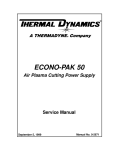
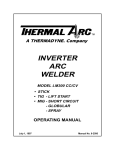
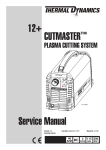
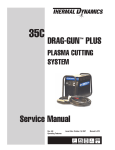
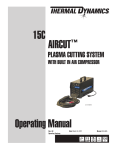

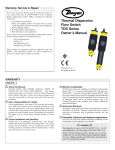

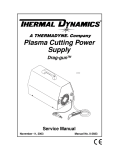

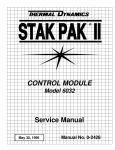
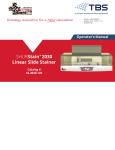
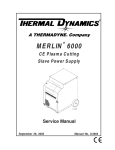
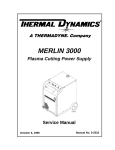
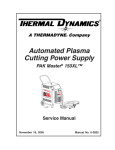

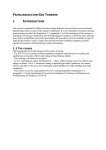
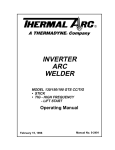
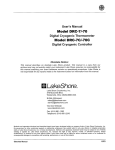
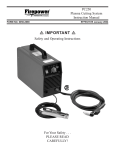
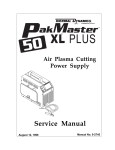
![PDF [1] - Dep SAE Soudage, Automatismes et Electronique location](http://vs1.manualzilla.com/store/data/005888267_1-8c649f384f0a877ffbc023ff9f75566c-150x150.png)